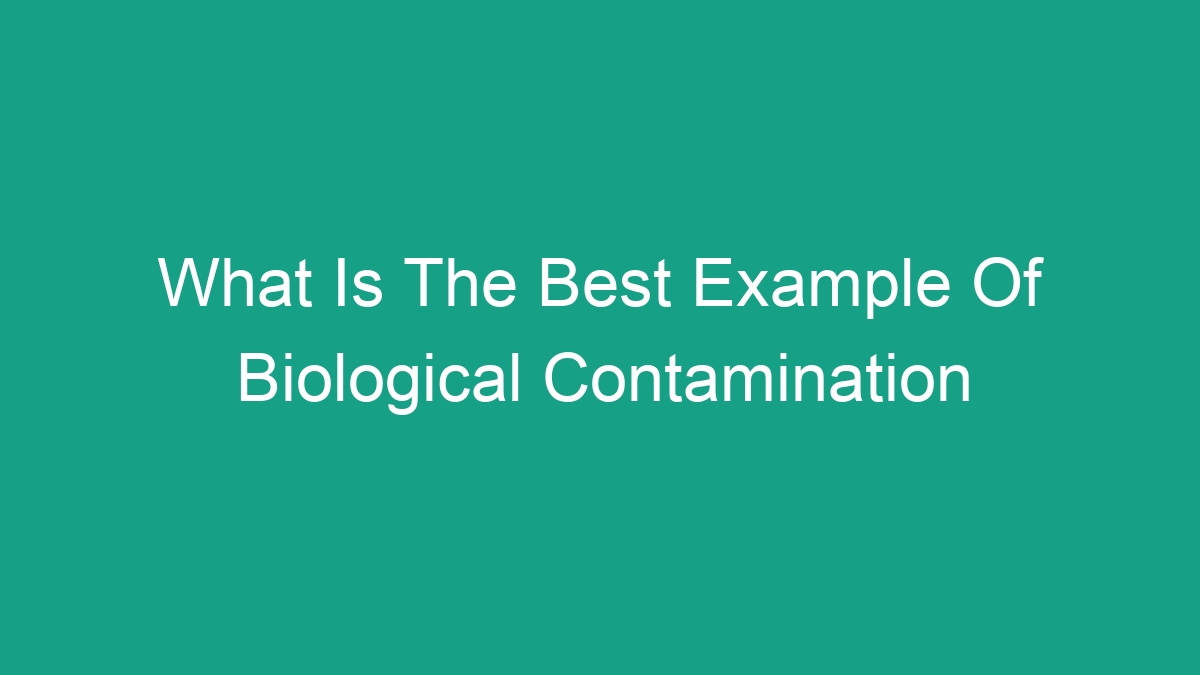
Biological contamination refers to the presence of living organisms, such as bacteria, viruses, fungi, and parasites, in a substance or environment where they are not supposed to be. This contamination can occur in various settings, including food, water, air, and medical facilities. In this article, we will explore some of the best examples of biological contamination, the potential risks associated with each example, and how to prevent them.
Food Contamination
Food contamination is one of the most common examples of biological contamination. It occurs when food is contaminated with harmful bacteria, viruses, parasites, or toxins. This can happen at any stage of the food production process, including harvesting, processing, transportation, storage, and preparation. Some of the most common sources of food contamination include:
- Consuming raw or undercooked meat, poultry, seafood, and eggs
- Improper handling and storage of food
- Unsanitary cooking environment
- Infected food handlers
Food contamination can lead to foodborne illnesses, such as salmonella, E. coli, norovirus, and listeria, which can cause symptoms ranging from mild gastrointestinal discomfort to severe illness and even death.
Water Contamination
Water contamination occurs when water is polluted with harmful microorganisms or chemicals, making it unsafe for human consumption. Some of the most common sources of water contamination include:
- Industrial waste
- Agricultural runoff
- Sewage and wastewater
- Improper waste disposal
Biological contamination of water can result in waterborne diseases, such as cholera, typhoid fever, and hepatitis A, which can have serious health implications, especially in developing countries with limited access to clean water.
Air Contamination
Air contamination occurs when the air we breathe is contaminated with harmful biological agents, such as mold spores, pollen, bacteria, and viruses. Indoor air contamination can occur in buildings with poor ventilation, high humidity levels, and contaminated HVAC systems, while outdoor air contamination can be caused by industrial emissions, vehicle exhaust, and natural sources such as pollen and spores.
Biological air contamination can lead to respiratory infections, allergies, and other health issues, particularly in individuals with compromised immune systems or pre-existing respiratory conditions.
Medical Facility Contamination
Medical facility contamination refers to the presence of harmful microorganisms in healthcare settings, such as hospitals, clinics, and long-term care facilities. This type of contamination can occur through inadequate sterilization of medical equipment, improper disposal of medical waste, and the spread of infections between patients and healthcare workers.
Biological contamination in medical facilities can lead to healthcare-associated infections, which are a significant cause of morbidity and mortality among patients, particularly those with weakened immune systems.
Preventing Biological Contamination
Preventing biological contamination is crucial to protecting public health and reducing the risk of foodborne, waterborne, and airborne illnesses. Some effective measures to prevent biological contamination include:
- Proper food handling and hygiene practices in food production and preparation
- Regular testing and monitoring of water quality
- Improving ventilation and air filtration systems to reduce indoor air contamination
- Strict adherence to infection control protocols in medical facilities
By implementing these preventive measures, it is possible to minimize the risk of biological contamination and safeguard the health of individuals and communities.
FAQs
Q: What are the symptoms of biological contamination?
A: Symptoms of biological contamination can vary depending on the type of contaminant and the route of exposure. They may include gastrointestinal issues, respiratory problems, skin irritation, and fever.
Q: How can I protect myself from biological contamination?
A: Practice good hygiene, follow food safety guidelines, drink clean and safe water, and use appropriate personal protective equipment in high-risk environments.
Q: Why is it important to prevent biological contamination?
A: Preventing biological contamination is essential to protect public health, reduce the burden of infectious diseases, and ensure the safety of food, water, and healthcare facilities.
Q: What are some common sources of biological contamination in the home?
A: Common sources of biological contamination in the home include improperly stored food, unclean kitchen surfaces, mold and mildew, and poor indoor air quality.
In conclusion, biological contamination can pose significant risks to human health and the environment. By understanding the examples of biological contamination and the measures to prevent them, we can work towards creating safer and healthier environments for all.



